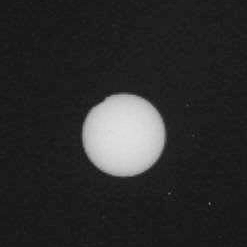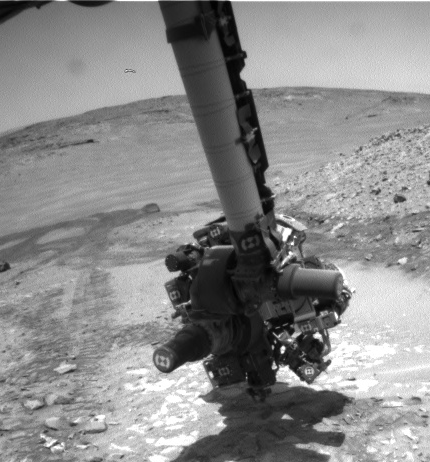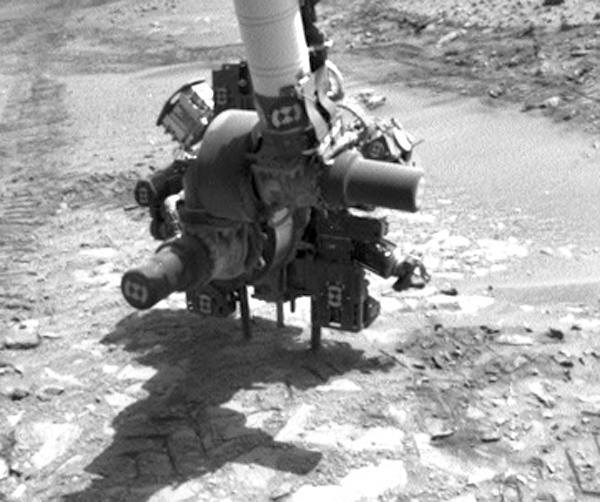Rover Curiosity: the interesting is just beginning
A couple of weeks ago, NASA officials extended funding for the Curiosity expedition, but they also complained that the rover travels too much and studies little. The day before yesterday, the scientific team replied: “we have already arrived!”. True, many journalists understood them literally: as if everyone had arrived, the goal was achieved, but in reality the rover is just starting its main scientific program, for which it was sent.

For more than a year, Curiosity moved along Sharpe Mountain, circling black sand piles at the foot, and stepping up to a more promising, from the scientific point of view, terrain. As a guideline, we chose a conditional Entry Point, from which it was planned to move to storm the mountains. Suddenly, rough terrain and hard stones along the way led to increased wheel wear, so the rover had to move more slowly, carefully choosing the route, circling dangerous placers.
Two terrestrial years have passed - as many as were assigned to the entire mission, and the goals - Sharpe Mountain, and even the Point of Entry - were far away. But the prolonged jogging brought results - Curiosity reached the ravines, at the bottom of which were expected rocks that had not previously been encountered. In addition, the bottom of the ravines beckoned with soft sand, which could be safe for the wheels to move around.
')

The rover rushed to conquer the Hidden Valley ravine, but also threw sand at surprises. Those dunes that were encountered earlier on the way, and which cover the bottom of ravines, consist in fact not of sand, but of a finer fraction, which American geologists call silt, and our “aleurite” is a transitional form between sand and dust. By mechanical properties, Martian aleurite is most similar to cement or cocoa powder. The rover was tested in the desert, but on ordinary sand, so the behavior on such a surface on Mars was unstable.
The dunes were deep. And although Curiosity did not sink and was not elm, the movement in the dunes was considered unpredictable and dangerous.

The rover passed back, and on the way back found a curious bright rock, which was called Bonanza King - the term of the gold rush times, denoting a rich ore vein.

Along the way, another Martian solar eclipse was filmed:

Curiosity was made to drill. I checked the stability of my position, kissed the stone with a drill.

Pay attention to the push that occurs after touching the ground with two stops. This rover simulates the load that a drill requires.
The next test was on vibration.

The test result showed that the rock is too loose and the place for the well was chosen poorly. From this venture had to give up and leave the Hidden Valley. At the same time, Bonanza King did not disappoint. ChemCam spectrometer analysis showed an elevated silicon content, and at a concentration that was practically not encountered during the entire Mars exploration.

In the picture you can see the result of the work of two tools at once: marks to the right of the ChemCam laser, and a trace from the DRT brush to the left.
Spirit found more silicon only when it excavated the deposition of the purest silicon dioxide, in the form of white sand.
Bonanza King had to leave. Bypassing the side, and after looking around, Curiosity chose a new target in the ravines, and again fearlessly moved forward. This time the hollow was called Amargosa Valley. It is much more spacious and not all blocked by dunes, so you can go.

And here is a 360-degree spherical panorama of the entrance to the Amargosa Valley, collected and processed by photo artist Andrey Bodrov (screen clickable, it’s best to open in a new tab):

The target for the study was called Pahrump Hills. It represents the exit layer of light rock. It is expected that even more silicon will be found there.

The planetary crust, that of the Earth, that Mars is largely composed of silicon, so there is not so much interest in himself, as his concentration. It is believed that water played an important role in the enrichment of the silicon with silicon. In addition, the crystalline form of silicon found will tell more about the tectonic history of Mars, about how the crust of the planet was formed. Previous rovers had no crystallographic research capabilities.
After Pahrump Hills, NASA scientists decided to change the route, forget about the previously planned Entry Point, and immediately go to the mountain. Just a few days ago, it was thought: “that scientists wouldn’t drive Curiosity back to the shore again, but moved by ravines to the mountain ...” And please: dreams come true. At the same time saved a kilometer.

A lot of interesting things are expected ahead:
Murray Buttes six meter table mountains;

the most ancient surface of Murray Formation, which still remembers the impact of the asteroid that gave rise to the Gale crater, and other blows from the times of heavy meteorite bombardment ;

hypnotic, in its blackness, sand dunes, which for a long time did not allow the rover to the mountain;

The hematite ridge , which may turn out to be the remains of an ancient river in which chemolithotrophic bacteria (possibly) lived;

clay deposits that could preserve organics;

deep canyon, washed with glacial waters in sulphate sediments, not so interesting from the point of view of astrobiology, as from the side of artistic photography;

and, finally, boxwork sediments, 800 meters from the foot, which may turn out to be a dry and petrified bottom of the sea bay that once filled the Gale crater.

Now this boxwork is considered to be the finishing point of the Curiosity route, but it’s impossible to say whether it can get there and stay there forever. We'll see.
You can still watch via Twitter official or zelenyikot .

For more than a year, Curiosity moved along Sharpe Mountain, circling black sand piles at the foot, and stepping up to a more promising, from the scientific point of view, terrain. As a guideline, we chose a conditional Entry Point, from which it was planned to move to storm the mountains. Suddenly, rough terrain and hard stones along the way led to increased wheel wear, so the rover had to move more slowly, carefully choosing the route, circling dangerous placers.
Two terrestrial years have passed - as many as were assigned to the entire mission, and the goals - Sharpe Mountain, and even the Point of Entry - were far away. But the prolonged jogging brought results - Curiosity reached the ravines, at the bottom of which were expected rocks that had not previously been encountered. In addition, the bottom of the ravines beckoned with soft sand, which could be safe for the wheels to move around.
')

The rover rushed to conquer the Hidden Valley ravine, but also threw sand at surprises. Those dunes that were encountered earlier on the way, and which cover the bottom of ravines, consist in fact not of sand, but of a finer fraction, which American geologists call silt, and our “aleurite” is a transitional form between sand and dust. By mechanical properties, Martian aleurite is most similar to cement or cocoa powder. The rover was tested in the desert, but on ordinary sand, so the behavior on such a surface on Mars was unstable.
The dunes were deep. And although Curiosity did not sink and was not elm, the movement in the dunes was considered unpredictable and dangerous.

The rover passed back, and on the way back found a curious bright rock, which was called Bonanza King - the term of the gold rush times, denoting a rich ore vein.

Along the way, another Martian solar eclipse was filmed:

Curiosity was made to drill. I checked the stability of my position, kissed the stone with a drill.

Pay attention to the push that occurs after touching the ground with two stops. This rover simulates the load that a drill requires.
The next test was on vibration.

The test result showed that the rock is too loose and the place for the well was chosen poorly. From this venture had to give up and leave the Hidden Valley. At the same time, Bonanza King did not disappoint. ChemCam spectrometer analysis showed an elevated silicon content, and at a concentration that was practically not encountered during the entire Mars exploration.

In the picture you can see the result of the work of two tools at once: marks to the right of the ChemCam laser, and a trace from the DRT brush to the left.
Spirit found more silicon only when it excavated the deposition of the purest silicon dioxide, in the form of white sand.
Bonanza King had to leave. Bypassing the side, and after looking around, Curiosity chose a new target in the ravines, and again fearlessly moved forward. This time the hollow was called Amargosa Valley. It is much more spacious and not all blocked by dunes, so you can go.

And here is a 360-degree spherical panorama of the entrance to the Amargosa Valley, collected and processed by photo artist Andrey Bodrov (screen clickable, it’s best to open in a new tab):

The target for the study was called Pahrump Hills. It represents the exit layer of light rock. It is expected that even more silicon will be found there.

The planetary crust, that of the Earth, that Mars is largely composed of silicon, so there is not so much interest in himself, as his concentration. It is believed that water played an important role in the enrichment of the silicon with silicon. In addition, the crystalline form of silicon found will tell more about the tectonic history of Mars, about how the crust of the planet was formed. Previous rovers had no crystallographic research capabilities.
After Pahrump Hills, NASA scientists decided to change the route, forget about the previously planned Entry Point, and immediately go to the mountain. Just a few days ago, it was thought: “that scientists wouldn’t drive Curiosity back to the shore again, but moved by ravines to the mountain ...” And please: dreams come true. At the same time saved a kilometer.

A lot of interesting things are expected ahead:
Murray Buttes six meter table mountains;

the most ancient surface of Murray Formation, which still remembers the impact of the asteroid that gave rise to the Gale crater, and other blows from the times of heavy meteorite bombardment ;

hypnotic, in its blackness, sand dunes, which for a long time did not allow the rover to the mountain;

The hematite ridge , which may turn out to be the remains of an ancient river in which chemolithotrophic bacteria (possibly) lived;

clay deposits that could preserve organics;

deep canyon, washed with glacial waters in sulphate sediments, not so interesting from the point of view of astrobiology, as from the side of artistic photography;

and, finally, boxwork sediments, 800 meters from the foot, which may turn out to be a dry and petrified bottom of the sea bay that once filled the Gale crater.

Now this boxwork is considered to be the finishing point of the Curiosity route, but it’s impossible to say whether it can get there and stay there forever. We'll see.
You can still watch via Twitter official or zelenyikot .
Source: https://habr.com/ru/post/236659/
All Articles